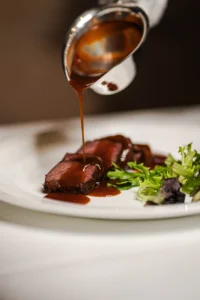Indian Food Fine Dining: How It Represents Heritage and Innovation
Indian food fine dining has long been a favourite worldwide, admired for its depth of flavour, vibrant colours, and diverse ingredients. It holds a special place in the world of fine dining, where it is celebrated for both its heritage and its capacity for innovation. Indian food is not just about taste; it’s a reflection of centuries-old traditions, regional influences, and an evolving culinary art form. This article explores the cultural significance of Indian food in fine dining, shedding light on how it represents both heritage and innovation.
The Heritage of Indian Food
Indian food deeply roots itself in history and culture. The country’s vast geography and rich history have shaped its diverse culinary landscape. From the aromatic spices of the north to the coconut-rich dishes of the south, Indian food tells the story of its people, their beliefs, and their way of life.
Regional Diversity and its Influence
India’s culinary traditions are as varied as its landscapes. In the north, you’ll find dishes like tandoori meats, butter chicken, and biryani. These dishes often feature bold flavours and are cooked with a variety of techniques such as roasting, grilling, and slow cooking. On the other hand, in the south, rice-based dishes like dosa, idli, and sambar are commonly enjoyed, often served with coconut chutneys and tangy curries.
Every region in India has its own signature dishes, which have evolved over generations. Local customs, climate, and the availability of produce often tie the flavours, ingredients, and cooking methods used. For example, Bengali cuisine uses mustard oil and spices, while South Indian food extensively uses curry leaves. Both highlight how Indian food represents regional heritage.
The Spiritual and Symbolic Meaning of Indian Cuisine
Indian food deeply connects to the country’s spirituality and religious practices. Chefs prepare many dishes for festivals, ceremonies, or religious observances. Food in India is often considered sacred and is prepared with reverence. The vegetarianism prevalent in many Indian communities is rooted in religious beliefs that value non-violence and respect for all living beings.
The concept of prasad, which refers to food offered to gods during religious rituals, showcases how food is not just sustenance, but a spiritual offering. The spiritual aspect of food plays a key part in its heritage, making it more significant in fine dining establishments.
The Rise of Indian Food in Fine Dining
Over recent decades, Indian food has transitioned from street food to gourmet cuisine, making its mark in fine dining restaurants worldwide. As the global palate has become more adventurous, chefs have sought to elevate Indian food to new heights. This journey has been driven by the desire to preserve traditional flavours while embracing modern culinary techniques.
Elevating Tradition Through Innovation
One of the key factors in Indian food’s success in fine dining is its ability to balance tradition and innovation. Indian chefs, both in India and abroad, have started experimenting with familiar dishes, creating refined versions of traditional favourites. For example, dishes like chicken tikka masala or paneer butter masala are staples in Indian cuisine. Chefs often give them a fine-dining twist by adjusting the presentation, flavours, and textures.
The Fusion of Global Ingredients
Another way Indian cuisine has evolved in fine dining is through the fusion of global ingredients with traditional Indian recipes. This fusion approach allows chefs to experiment and create unique dishes that offer new experiences for diners. For example, Indian spices can now be paired with ingredients like truffle oil or foie gras, creating a blend of Eastern and Western culinary traditions. These experiments have added new layers to Indian cuisine and helped it gain recognition in the world of haute cuisine.
Platform for Innovation: Indian Food Fine Dining
Indian food, steeped in tradition, thrives in the fine dining scene due to its capacity for innovation. Indian cuisine provides a broad canvas for chefs to explore new ideas, whether through new cooking techniques, presentation styles, or flavour combinations.
Modern Techniques in Traditional Dishes
The use of modern cooking techniques in Indian food helps preserve the authenticity of traditional recipes while enhancing their appeal. Techniques such as smoking, fermentation, or even the use of liquid nitrogen bring out the flavours in new ways, enhancing the dining experience. These techniques also allow chefs to create visually striking presentations that elevate the perception of Indian food in fine dining.
For instance, dal (lentils) might be served as a foam or a mousse, transforming the humble dish into something visually sophisticated while keeping its rich, comforting flavour intact. These innovative approaches have made Indian food a popular choice for fine dining enthusiasts.
Creativity and Presentation
Presentation plays a significant role in fine dining, and Indian cuisine is no exception. The colourful and vibrant nature of Indian dishes lends itself perfectly to artful plating. Furthermore, by reinterpreting traditional Indian food, chefs can create visually stunning dishes that enhance the dining experience.
Imagine a plate of butter chicken served in an elegant, minimalistic style, or a plate of dosa arranged as a geometric masterpiece. These visual representations of Indian food show how its presentation mirrors the creativity of fine dining. It offers a feast for both the eyes and the palate.
Indian Cuisine’s Impact on Global Fine Dining Trends
The influence of Indian cuisine in fine dining has grown exponentially in recent years. Renowned chefs, especially from the Indian diaspora, have introduced Indian-inspired dishes to Michelin-starred restaurants. This showcases the cuisine’s richness to a global audience.
The Rise of Indian Chefs in Fine Dining
Indian chefs have played a crucial role in the globalisation of Indian food. Many have trained in top culinary institutions, blending their knowledge of Indian food with international techniques. As a result, they’ve brought new flavours and perspectives to the fine dining world. Chefs like Vineet Bhatia, Manish Mehrotra, and Atul Kochhar have earned recognition for their work in elevating Indian cuisine to the fine dining stage.
These chefs often infuse their dishes with a sense of personal identity, incorporating their own unique interpretations of Indian food. This personal touch adds a layer of innovation that continues to redefine what Indian food can be in a fine dining context.
Indian Food’s Future in Fine Dining
The future of Indian food in fine dining looks bright. As food cultures continue to cross borders, Indian food will remain at the forefront of global culinary innovation. The increasing demand for authenticity, combined with a desire for creativity, will continue to push Indian food into exciting new territory.
Sustainability and Indian Cuisine
Sustainability is also a growing concern in the fine dining world, and Indian cuisine offers unique solutions. The use of plant-based ingredients, such as lentils, chickpeas, and vegetables, is a core part of Indian food. These ingredients are nutritious and have a low environmental impact. They are ideal for fine dining restaurants focused on sustainability.
Indian food emphasizes balance, using spices to enhance both flavour and nutrition. This will inspire chefs to create sustainable, health-conscious dishes for modern diners.
Conclusion
Indian food is more than just a collection of flavours; it is a cultural narrative, a celebration of history, and a testament to the ingenuity of generations of chefs. In the world of fine dining, it has found a unique position, blending tradition and innovation. Through regional diversity, modern techniques, and creative presentations, Indian food is continually evolving, making its mark on global cuisine. As chefs experiment with new ideas, Indian food will remain a key player in fine dining. Moreover, it offers an exciting journey for both the senses and soul.

